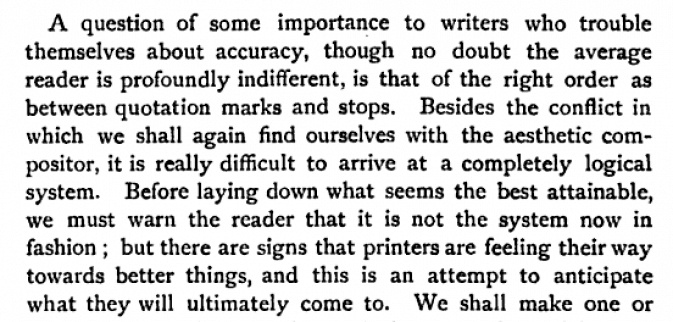Today, as promised, we’ll talk about how to mix quotation marks with other punctuation.
Quotation Marks with Commas and Periods
One of the most common question people ask me is whether periods and commas go inside or outside a closing quotation mark, and there’s a reason everyone is confused: the rules in American English are different from the rules in British English, so if you’re regularly reading American and British publications, such as the BBC and CNN websites, you’ll regularly see it done different ways.
In America, we use a hard-and-fast rule that was supposedly designed by compositors to protect the tiny commas and periods (1, 2). We always put periods and commas inside quotation marks.
In Britain, they use rules that require the writer to determine whether the period or comma belong with the quotation or are part of the larger sentence. It appears that early champions of this logical system were H.W. Fowler and F.G. Fowler who wrote the classic 1906 British usage guide The King’s English (3). In it, the brothers describe the British logical system of punctuation. They note that they are in conflict with compositors, people who set type, but the Fowlers believe their system is better.
In short, my U.S.-centric memory trick is to remember that inside the U.S., periods and commas go inside quotation marks.
Squiggly said, “I hate packing for a vacation.”
“I hate packing for a vacation,” said the yellow snail.
I also have to share a funny comment from the website. Michael from the University of Tennessee in Knoxville said, “Almost 60 years ago a linotype operator told me, ‘Commas and periods always go inside the quotation marks because if we wait for the [editorial side] to quit arguing about it, we’d never get the paper out.’”
That made me laugh, and I’ll add that this is the rule that I get the most pushback on. It is a hard-and-fast rule of American English, but every time I post something about it, I get all kinds of comments from Americans who say they think it’s a stupid rule, they don’t care what the stylebooks say, and they’re going to do it the British way. So there! And all I can say is that it’s your choice. I can only tell you the rules. If you want to do it some other way, that’s completely up to you.
Quotation Marks with Exclamation Points and Question Marks
When combining exclamation points and question marks with quotation marks, however, Americans follow the same logical system as the British. Where you place the other marks relative to the quotation mark depends on the context of the quotation.
If the whole sentence, including the quotation, is a question or an exclamation, then the question mark or exclamation point goes outside the closing quotation mark; but if only the part inside the quotation marks is a question or exclamation, then the question mark or exclamation point goes inside the closing quotation mark. Examples will help.
In this sentence, the whole thing is a question, so the question mark goes after the closing quotation mark:
Did she ask you whether you enjoyed Aardvark’s song “Ode to Ants”?
However, in this sentence only the part in quotation marks is a question, so the question mark goes inside the closing quotation mark:
I love Aardvark’s song “Where Have All the Ants Gone?”
The same rules apply for exclamation points.
Quotation Marks with Semicolons and Colons
With semicolons, colons, asterisks, and dashes, we get back to a simple rule. They go outside the closing quotation mark.
I love “Ode to Ants”; it’s insightful and moving.
“Ode to “Ants”: A Moving and Insightful Song
Aardvark’s greatest hit is “Ode to Ants.”*
I love “Ode to Ants”–it’s insightful and moving.
Summary
In American English, periods and commas always go inside the closing quotation mark; semicolons, colons, asterisks, and dashes always go outside the closing quotation mark; and question marks and exclamation points require that you analyze the sentence and make a decision based on context.
References
- pthompsen, “Typesetters’ Quotes vs. Logical Quotes” MacHeist Forum. click on this link (accessed August 22, 2011).
- 2. Wikipedia contributors, “Quotation mark,” Wikipedia, The Free Encyclopedia, Click here to see quotation mark (accessed August 22, 2011).
- 3. Fowler H.W. and Fowler F.G., The King’s English, Oxford at the Clarendon Press, 1906 (accessed via Google Books August 22, 2011 Ckick this)
- *co-written with Squiggly
- Mignon Fogarty is Grammar Girl and the founder of Quick and Dirty Tips. Check out her New York Times best-seller “Grammar Girl’s Quick and Dirty Tips for Better Writing” and her 2018 tip-a-day calendar.





